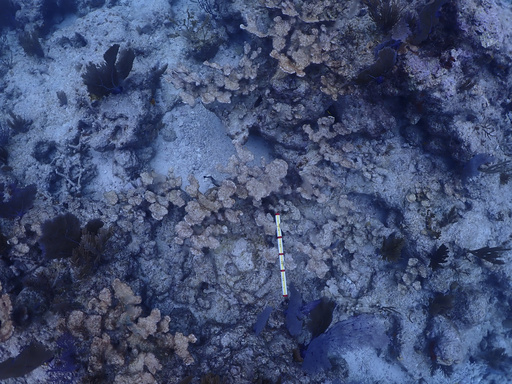Record hot seawater killed more than three-quarters of human-cultivated coral that scientists had placed in the Florida Keys in recent years in an effort to prop up a threatened species that’s highly vulnerable to climate change, researchers discovered.
Researchers from the National Oceanic and Atmospheric Administration this week returned to five reefs where they planted staghorn and elkhorn coral, both classified as threatened in the endangered species list, to see how the repopulated critters had survived prolonged water temperatures in the 90s (30s Celsius) last summer and fall. Most of them didn’t. They saw widespread death in both repopulated and wild coral on five Florida Keys reefs.
Scientists blame human-caused climate change, with a boost from a natural El Nino, for making the water too hot for the delicate coral, which are animals, to survive. After trying to rescue coral during heat last summer, this was scientists’ first winter look to see what survived.
Only 22% of the 1,500 repopulated staghorn coral that they surveyed was still alive, NOAA said. Only about 5% of 1,000 replanted elkhorn corals were alive. At Looe Key, the southernmost of the reefs they looked at, “we did not find any live elkhorn or staghorn coral, not wild, not planted,” said coral biologist Katey Lesneski, research and monitoring coordinator for NOAA’s Mission: Iconic Reefs.
“It’s really horrible to witness,” Lesneski said in an interview just two days after the dives finished. “Besides thinking about the economic and the ecological benefits reefs and these corals provide, there’s the loss of intrinsic beauty that many people come to the Keys to see and experience. And just to take in the loss of that is also very upsetting.”
“There’s still a lot of data to be collected to really understand the full impact,” Lesneski said. “But we certainly have not seen something like this in recorded human history.”
Normally these are corals with robust red, orange, tan and brown colors. But what Lesneski and other researchers saw when they dove were dead coral with brownish green algae settled on the lifeless skeleton to make it look “quite drab,” she said.
Not only are staghorn and elkhorn populations dwindling so much that they are on the endangered list, but they are crucial to the vast community of different types of coral because they are framework builders that provide the “structural framework” for coral habitat, Lesneski said.
Even though the researchers were diving to check up on the human-planted coral at Horseshoe Reef, the second northernmost reef they looked at, an area Lesneski gazed at was once a wild colony of elkhorn coral that was more than 100 years old.
“I saw them in June and they were alive. In July, they were starting to die because of the heat stress,” Lesneski said. “And at this point we have not even found a patch of living tissue on any of those wild colonies at Horseshoe Reef. So that was very hard to see.”
In the five reefs the team visited, they did see some wild coral alive and well, Lesneski said. Brain or boulder coral seemed to do better, but still had large amounts of death, she said.
The joint federal-private project plans to spend at least $97 million to place coral species grown on land or in ocean nurseries across seven sites. Some of the species are the same as what was already in the water and had been badly hurt by warmer seas, but some had been crossbred to be heartier, Lesneski said. It’s too early to tell whether the heartier coral survived more, she said.
NOAA measured days of water temperature at the planting sites hitting 93 degrees (34 degrees Celsius) with it reaching 94 degrees at another location, Lesneski said. She and others said that’s just too hot.
“What happened in 2023 was absolutely devastating,” said retired NOAA coral monitoring chief Mark Eakin, who now is corresponding secretary for the International Coral Reef Society. “They were actually seeing temperatures that they didn’t think were possible.”
While the Caribbean coral reefs were devastated during the record high water temperatures last year, “2023 wasn’t as bad as we feared in the rest of the world,” Eakin said.
Earlier this month, NOAA revised its coral reef watch alert system to add new higher level of heat stress categories because of worsening climate change. It’s the equivalent of adding a Category 6 to hurricanes, Lesneski said.
Eakin and the University of Victoria coral biologist Julia Baum both said this raises legitimate concerns about trying to repopulate coral reefs by putting the coral back in water that is just getting too warm.
“Coral restoration is almost certainly doomed to fail under climate change,” Baum said in an email. “Attempting coral restoration in today’s hot oceans is like trying to refurnish a house while it’s still on fire.”
“Our oceans are now dangerously hot for corals and continuing to heat up because of climate change,” Baum said.
Lesneski said she understands that concern and researchers are looking to see what they could do to breed more heat-resistant coral.
“It’s not a silver bullet,” Lesneski said. “There has to be global reductions in fossil fuel derived emissions, major policy changes. But for now, if we want to have any of the economic or ecological benefits of reefs, we do have to do our best to conserve, be good stewards and restore to the degree we can.”
___
Read more of AP’s climate coverage at http://www.apnews.com/climate-and-environment
___
Follow Seth Borenstein on X at @borenbears
___
The Associated Press’ climate and environmental coverage receives financial support from multiple private foundations. AP is solely responsible for all content. Find AP’s standards for working with philanthropies, a list of supporters and funded coverage areas at AP.org.



